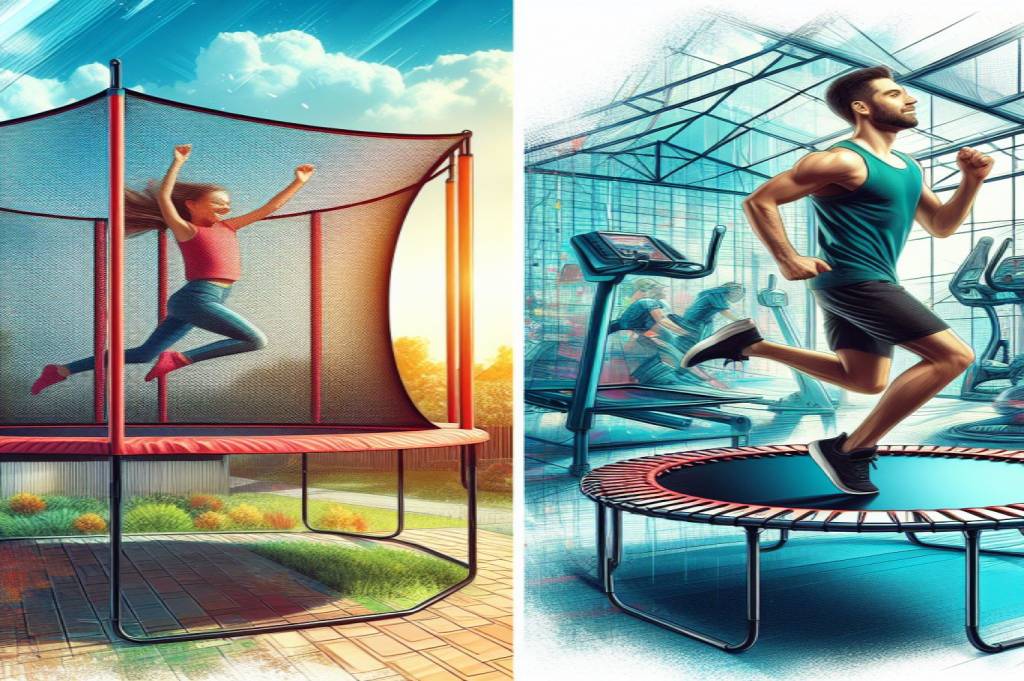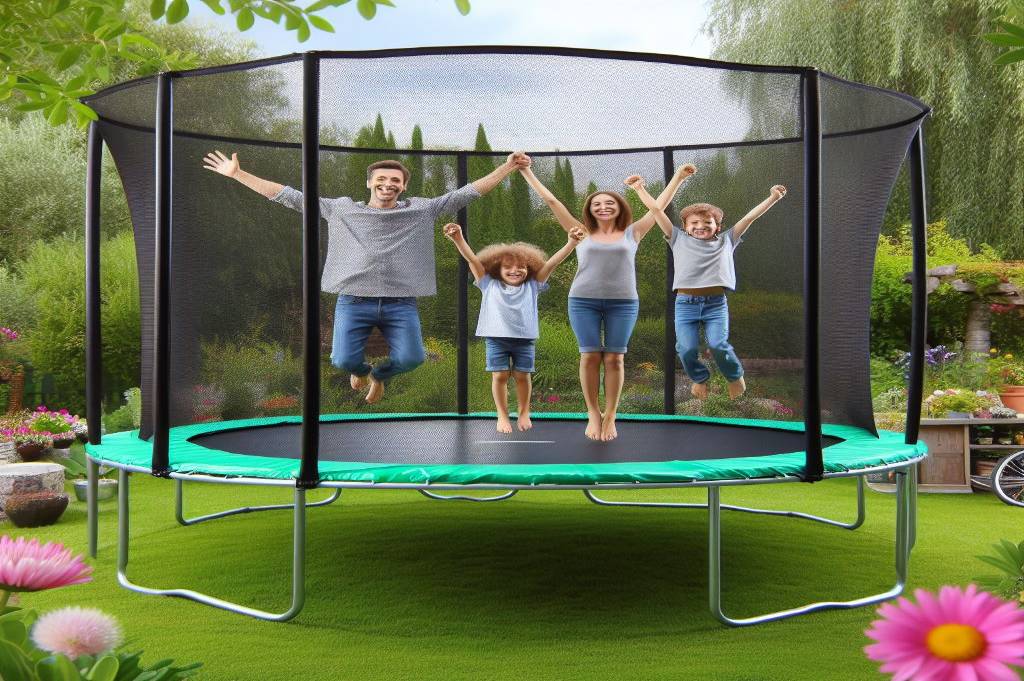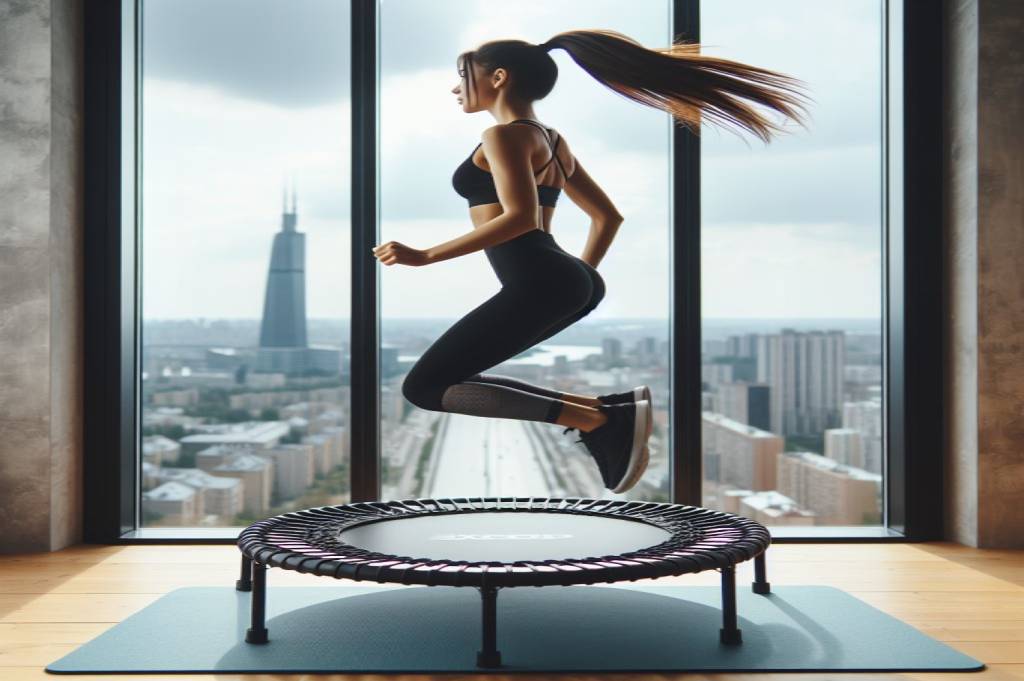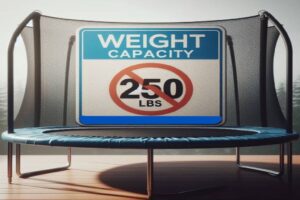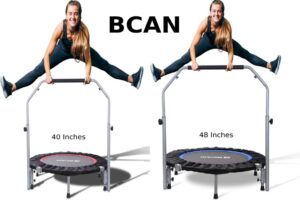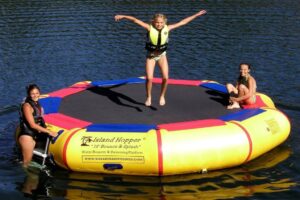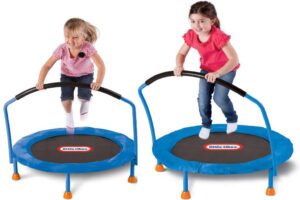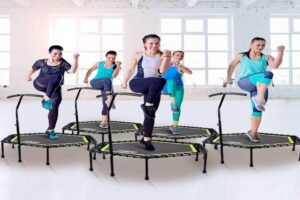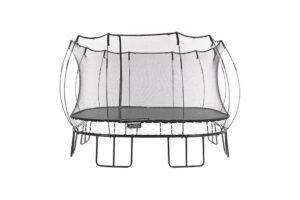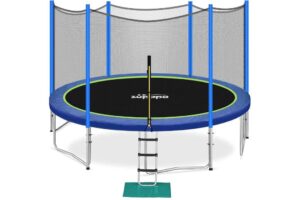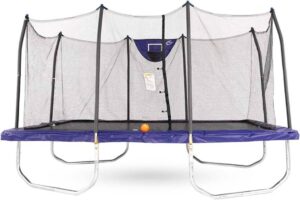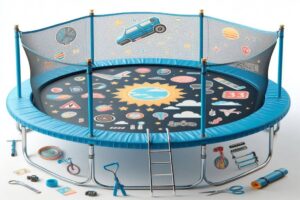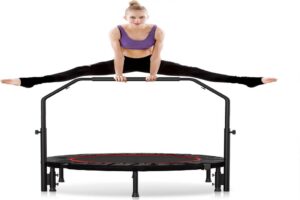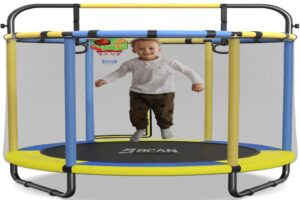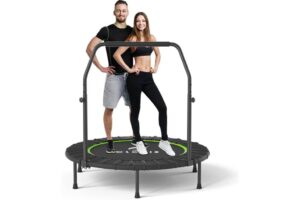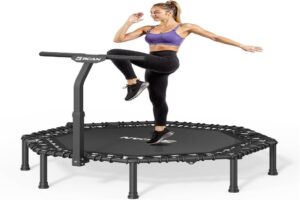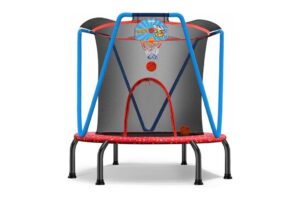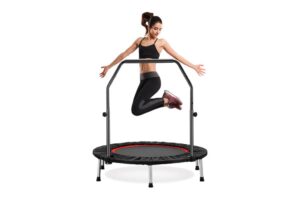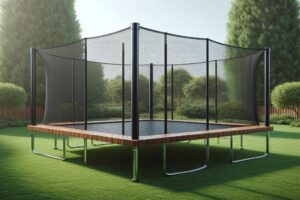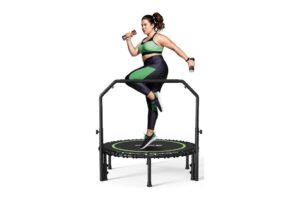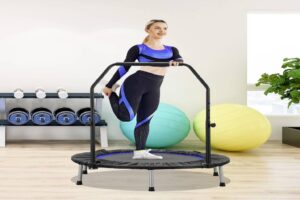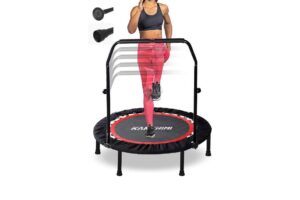Introduction
Trampolines vs. Rebounders
Welcome to our comprehensive guide “Trampolines vs. Rebounders: Drive Your Fitness Forward” where you’ll differentiate between trampolines and rebounders. As, when it comes to fitness equipment for bouncing exercises, the decision often boils down to choosing between trampolines vs. rebounders. These two options offer unique advantages and cater to different fitness goals. Understanding the distinctions between trampolines and rebounders is crucial for selecting the most suitable option for your needs.
Trampolines vs. rebounders represent distinct categories of bouncing devices, each with its own set of characteristics and benefits. While trampolines are known for their larger size and dynamic bounce, rebounders are preferred for their compactness and low-impact design.
Trampolines are expansive structures equipped with springs that provide a lively and exhilarating bounce. They are commonly used for recreational jumping and acrobatic activities. In contrast, rebounders are smaller and feature a bungee cord or spring system designed for gentle, controlled bouncing exercises.
Here, we will explore the differences between trampolines vs. rebounders in detail, examining factors such as size, bounce quality, versatility, and safety. By understanding these distinctions, you’ll be better equipped to make an informed decision about which bouncing device aligns with your fitness preferences and goals.
Stay tuned as we dive deeper into the world of trampolines vs. rebounders, unraveling the nuances that set them apart and discovering how they can elevate your fitness journey. Whether you’re seeking high-flying thrills or low-impact workouts, there’s a bouncing solution tailored to your needs.
Let’s start by defining each equipment and highlighting their primary characteristics.
What are Trampolines?
Trampolines stand as iconic symbols of fun and fitness, offering an exhilarating way to bounce your way to better health. In the ongoing discussion of trampolines vs. rebounders, it’s essential to grasp the unique characteristics and benefits of trampolines.
Defining Trampolines
Trampolines are large, spring-supported structures designed for recreational jumping, acrobatics, and fitness training. They come in various sizes, ranging from backyard models suitable for family entertainment to professional-grade versions utilized in gymnastics and sports facilities. The defining feature of trampolines is their expansive jumping surface, which allows for high-flying manoeuvres and energetic bouncing experiences.
In the trampolines vs. rebounders debate, trampolines are distinguished by their larger size and dynamic bounce. Unlike rebounders, which are compact and designed for low-impact exercises, trampolines provide a more robust platform for a wide range of activities. Whether you’re looking to perform flips, tricks, or simply enjoy recreational jumping, trampolines offer unparalleled versatility and excitement.
Types of Trampolines
Trampolines come in various shapes, sizes, and designs, catering to different needs and preferences. One of the most common types is the backyard trampoline, typically found in residential settings and ranging in size from small to large. These trampolines are ideal for family entertainment and recreational bouncing.
Gymnastic trampolines, on the other hand, are engineered for professional athletes and gymnasts, featuring a sturdy frame, high-quality springs, and a larger jumping surface to facilitate advanced manoeuvres and routines. Mini trampolines, also known as fitness or exercise trampolines, are compact and portable, making them suitable for indoor use and aerobic workouts. Additionally, there are specialty trampolines designed for specific purposes, such as water trampolines for aquatic fun and inflatable trampolines for inflatable parks and play areas. Each type of trampoline offers unique features and benefits, allowing users to choose the one that best suits their fitness goals, space constraints, and budget.
Primary Uses and Benefits of Trampolines
Trampolines cater to diverse fitness goals and preferences. They are commonly used for cardiovascular workouts, strength training, and improving balance and coordination. Additionally, trampolines provide a fun and engaging way to burn calories, reduce stress, and enhance overall well-being. Whether you’re a fitness enthusiast, athlete, or simply seeking an enjoyable outdoor activity, trampolines offer something for everyone.
What are Rebounders?
In the realm of bouncing fitness equipment, rebounders hold a special place, offering a compact and versatile alternative to traditional trampolines. As we delve into the comparison of trampolines vs. rebounders, it’s essential to understand the unique characteristics and benefits of rebounders.
Defining Rebounders
Rebounders, also known as mini-trampolines, are smaller, portable versions of trampolines designed for low-impact aerobic exercises and rehabilitation purposes. They feature a sturdy frame equipped with either bungee cords or springs, providing a gentle and controlled bounce. Unlike trampolines, which offer a larger jumping surface and dynamic bounce, rebounders prioritize stability and safety, making them suitable for users of all ages and fitness levels.
Distinct Features from Trampolines
Rebounders, in contrast to trampolines, exhibit distinct features that cater to specific fitness and rehabilitation needs. One prominent characteristic of rebounders is their compact size and lightweight design, making them portable and convenient for indoor use.
Unlike the expansive jumping surface of trampolines, rebounders typically feature a smaller rebounding area, ideal for low-impact exercises and controlled bouncing movements. Additionally, rebounders often utilize bungee cords or spring systems that offer a gentler and more forgiving bounce, making them suitable for individuals seeking a less intense workout or recovering from injury.
The sturdy frame construction and stability of rebounders provide a secure platform for users to perform a variety of exercises, including jogging, balance drills, and aerobic routines. With their emphasis on safety, versatility, and convenience, rebounders offer a unique and effective solution for individuals looking to incorporate bouncing exercises into their fitness regimen.
Primary Uses and Benefits of Rebounders
Rebounders cater to a wide range of fitness goals and applications. They are commonly used for cardiovascular workouts, lymphatic drainage, and improving core strength and stability. Additionally, rebounders offer a convenient way to incorporate bouncing exercises into your daily routine, whether at home, in the gym, or even while traveling. Their portable nature and ease of storage make them an ideal choice for individuals with limited space or mobility.
Size and Structure Comparison
Trampolines vs. Rebounders
When deliberating between trampolines and rebounders, understanding their size and structure is pivotal in making an informed decision. Let’s delve into a comprehensive comparison, analyze dimensions, materials, portability, storage considerations, weight capacity, and safety features of both bouncing devices.
Dimensions and Materials
Trampolines typically boast larger dimensions, offering expansive bouncing surfaces suitable for various activities. Constructed with durable steel frames and reinforced with galvanized springs or bungee cords, trampolines ensure longevity and resilience.
Meanwhile, rebounders feature a more compact design, making them ideal for indoor use or limited spaces. Their sturdy frames, often made of steel or aluminium, are supported by elastic bungee cords or springs, ensuring stability and durability during workouts.
Portability and Storage Considerations
Trampolines, due to their larger size, are less portable and may require ample outdoor space for setup. Limited space often poses a challenge when it comes to storage.
Conversely, rebounders are highly portable and lightweight, making them convenient for indoor use and travel. Their compact design facilitates easy storage, allowing users to stow them away when not in use.
Weight Capacity and Safety Features
Trampolines typically have higher weight capacities, accommodating multiple users simultaneously. Safety features such as enclosure nets, padding, and anchor kits are common additions, ensuring user protection during vigorous bouncing sessions.
Rebounders, although smaller in size, still offer substantial weight capacities suitable for most users. While they may lack enclosure nets, rebounders prioritize safety with sturdy frames and non-slip surfaces, minimizing the risk of accidents or injuries.
Bounce Quality and Performance
Trampolines vs. Rebounders
When it comes to bounce quality and performance, the choice between trampolines and rebounders hinges on factors such as spring systems vs. bungee cord systems, the impact on the jumping experience, and considerations for fitness and rehabilitation. Let’s analyse thoroughly so that you can make an informed decision.
Spring Systems vs. Bungee Cord Systems
Trampolines typically utilize spring systems to generate bounce, providing a lively and dynamic jumping experience. These metal springs are known for their responsiveness, allowing users to achieve impressive heights and execute various manoeuvres with ease.
In contrast, rebounders often feature bungee cord systems, which offer a gentler and more controlled bounce. The elasticity of bungee cords absorbs shock and minimizes impact on joints, making rebounders suitable for users seeking a low-impact workout option.
Impact on Jumping Experience
The choice between trampolines and rebounders significantly impacts the jumping experience. Trampolines, with their robust spring systems, deliver a high-energy bounce that appeals to thrill-seekers and fitness enthusiasts alike. The expansive jumping surface and responsive springs allow for dynamic movements and exhilarating aerial tricks.
In contrast, rebounders offer a softer and more forgiving bounce, making them ideal for users with joint issues or those undergoing rehabilitation. The controlled bounce of rebounders promotes stability and balance, enabling users to perform a wide range of exercises with confidence.
Considerations for Fitness and Rehabilitation
When comparing trampolines vs. rebounders for fitness and rehabilitation purposes, it’s essential to consider individual needs and goals. Trampolines are well-suited for cardiovascular workouts, strength training, and improving agility and coordination. The energetic bounce of trampolines provides an effective way to burn calories, build muscle, and enhance overall fitness levels.
On the other hand, rebounders offer a gentle yet effective solution for individuals recovering from injury or seeking low-impact exercises. The controlled bounce of rebounders promotes circulation, improves joint mobility, and aids in rehabilitation efforts.
Safety Considerations
Trampolines vs. Rebounders
Safety is paramount when it comes to using bouncing devices like trampolines and rebounders. Here, we’ll delve into key safety considerations, including frame stability and durability, surface area and jumping space, as well as safety enclosures and handlebars, to help you make an informed decision between trampolines vs. rebounders.
Frame Stability and Durability
Trampolines are typically equipped with robust steel frames designed to withstand rigorous bouncing activities. These frames provide stability and support, ensuring a secure platform for users to enjoy their bouncing experience. Additionally, trampolines are built to withstand outdoor elements, such as sun exposure and inclement weather, making them durable investments for backyard use.
In contrast, rebounders feature lightweight frames made of steel or aluminium, offering stability without the bulkiness of trampolines. While rebounders may not have the same weight-bearing capacity as trampolines, they still provide a stable platform for low-impact exercises and aerobic workouts.
Surface Area and Jumping Space
Trampolines offer expansive jumping surfaces, allowing for ample space to perform a wide range of jumps, flips, and tricks. However, the large surface area of trampolines also poses potential safety risks, as users may accidentally collide with each other or the frame during vigorous bouncing activities. To mitigate these risks, trampolines often come equipped with safety enclosures, which prevent users from falling off the trampoline while bouncing.
In contrast, rebounders feature smaller jumping surfaces, making them ideal for solo workouts or limited spaces. While rebounders may lack the jumping space of trampolines, they offer a safer alternative for users seeking a low-impact workout option.
Safety Enclosures and Handlebars
Safety enclosures are essential features of trampolines, providing a barrier around the jumping surface to prevent users from falling off or colliding with the frame. These enclosures typically consist of mesh netting attached to the trampoline frame, offering a safe and secure environment for bouncing activities. Additionally, some trampolines come equipped with handlebars or support bars, providing users with additional stability and support during workouts.
In contrast, rebounders may not have safety enclosures or handlebars, but they offer a lower risk of injury due to their smaller size and controlled bounce.
Versatility and Applications
Trampolines vs. Rebounders
Trampolines and rebounders are not just sources of entertainment; they are versatile tools with a wide range of applications, from fitness and exercise routines to rehabilitation and physical therapy. Here, we’ll delve into the diverse ways in which trampolines and rebounders can be utilized, helping you understand their respective benefits and applications.
Fitness and Exercise Routines
Trampolines and rebounders offer dynamic platforms for engaging fitness and exercise routines. Trampolines, with their expansive jumping surfaces and robust bounce, are ideal for cardiovascular workouts, strength training, and improving balance and coordination. They provide a fun and effective way to burn calories, build muscle, and enhance overall fitness levels.
Rebounders, on the other hand, offer a low-impact alternative for individuals seeking gentler exercises. Their compact size and controlled bounce make them suitable for aerobic workouts, jogging, and balance drills. Whether you’re looking to break a sweat or take it easy, trampolines and rebounders offer versatile options to meet your fitness needs.
Rehabilitation and Physical Therapy
Trampolines and rebounders are valuable tools for rehabilitation and physical therapy purposes. Trampolines, with their high-energy bounce and stability features, can aid in improving muscle strength, joint mobility, and overall coordination. They provide a safe and supportive environment for individuals recovering from injuries or surgeries, allowing them to gradually regain strength and mobility.
Rebounders, with their gentle bounce and controlled movement, are particularly beneficial for individuals with joint issues or mobility limitations. They promote circulation, improve balance, and help alleviate pain and stiffness associated with certain conditions. Whether used as part of a structured rehabilitation program or for ongoing maintenance, trampolines and rebounders offer therapeutic benefits for individuals seeking to regain or maintain their physical health.
Entertainment and Recreation
Beyond fitness and therapy, trampolines and rebounders offer endless opportunities for entertainment and recreation. Trampolines, with their exhilarating bounce and spacious jumping surfaces, provide hours of fun for individuals of all ages. They are perfect for backyard parties, family gatherings, and recreational bouncing activities.
Rebounders, with their compact size and portability, offer indoor entertainment options for rainy days or limited space. They provide a safe and enjoyable way to bounce, jump, and play, keeping both children and adults entertained for hours on end. Whether used for fitness, therapy, or pure enjoyment, trampolines and rebounders offer versatile and engaging experiences for individuals seeking active lifestyles.
Cost Comparison
Trampolines vs. Rebounders
When considering the purchase of a bouncing device, whether it’s a trampoline or a rebounder, understanding the cost implications is crucial. Here, we’ll compare the costs associated with trampolines vs. rebounders, including initial investment, maintenance and upkeep costs, and long-term value proposition, to help you make an informed decision.
Initial Investment
Trampolines generally require a higher initial investment compared to rebounders due to their larger size and more complex construction. Depending on the size, brand, and features, trampolines can range from a few hundred to several thousand dollars. Gymnastic-grade trampolines, designed for professional use, tend to be the most expensive, while backyard trampolines are more affordable but still require a significant upfront investment.
In contrast, rebounders are typically more budget-friendly, with prices ranging from around fifty to five hundred dollars depending on the quality and brand. Their compact size and simpler construction make rebounders a more accessible option for individuals on a tighter budget.
Maintenance and Upkeep Costs
Trampolines and rebounders both require some level of maintenance and upkeep to ensure their longevity and safety. Trampolines may require occasional replacement of springs, jumping mats, or safety enclosures, depending on usage and environmental factors. Additionally, trampolines need to be regularly inspected for wear and tear, and any necessary repairs should be addressed promptly to prevent accidents or injuries.
Rebounders, with their simpler construction and fewer moving parts, generally require less maintenance compared to trampolines. However, it’s still essential to keep the rebounding surface clean and free of debris and to inspect the frame and bungee cords or springs periodically for signs of damage.
Long-term Value Proposition
When evaluating the long-term value proposition of trampolines vs. rebounders, it’s essential to consider factors such as durability, versatility, and overall usage. Trampolines, with their larger size and robust construction, offer greater versatility and entertainment value for families and individuals seeking outdoor recreational activities. While they may require a higher initial investment and ongoing maintenance, trampolines provide long-term enjoyment and fitness benefits for years to come.
Rebounders, although smaller and less expensive, offer a more focused and low-impact workout option, making them suitable for individuals with specific fitness goals or space constraints. While rebounders may have a lower upfront cost and require less maintenance, their long-term value depends on individual usage and preferences.
Choosing the Right Option for You
Trampolines vs. Rebounders
Selecting between trampolines and rebounders boils down to understanding your fitness goals, space limitations, and budget considerations. Here, we’ll explore these factors to help you make an informed decision about which bouncing device aligns best with your needs and preferences.
Fitness Goals and Preferences
Consider your fitness goals and preferences when choosing between trampolines and rebounders. Trampolines offer a dynamic platform for high-intensity workouts, strength training, and acrobatic manoeuvres. If you enjoy high-flying thrills and want a versatile option for family entertainment, a trampoline might be the right choice for you.
On the other hand, rebounders provide a low-impact workout option, making them suitable for individuals with joint issues or those seeking gentler exercises. If you prefer a focused and controlled bouncing experience, a rebounder could be the ideal fit for your fitness routine.
Space Limitations and Convenience
Evaluate your available space and convenience preferences when deciding between trampolines and rebounders. Trampolines require ample outdoor space for setup and may not be suitable for individuals with limited yard space. Additionally, trampolines can be challenging to transport and store due to their size and weight.
If you have space constraints or prefer a portable option, a rebounder might be a more practical choice. Rebounders are compact, lightweight, and suitable for indoor use, making them convenient for home workouts or on-the-go bouncing sessions.
Budget Considerations
Take your budget into account when comparing trampolines vs. rebounders. Trampolines generally require a higher initial investment compared to rebounders due to their larger size and more complex construction. Additionally, trampolines may incur higher maintenance and upkeep costs over time.
If you’re on a tight budget or looking for a more affordable option, a rebounder could be a cost-effective solution. Rebounders offer a lower upfront cost and require less maintenance, making them accessible to individuals with limited financial resources.
Conclusion
Trampolines vs. Rebounders
As we conclude our exploration of trampolines vs. rebounders, it’s essential to recap the key differences between these bouncing devices, emphasize the importance of making an informed decision, and offer final thoughts on choosing the right option for your needs.
Trampolines and rebounders offer distinct features and benefits, catering to different fitness goals, space limitations, and budget considerations. Trampolines boast larger jumping surfaces and robust construction, making them ideal for high-intensity workouts and family entertainment. In contrast, rebounders provide a low-impact workout option with a smaller footprint, making them suitable for indoor use and individuals with joint issues. Understanding these differences is crucial for selecting the bouncing device that best aligns with your preferences and lifestyle.
When choosing between trampolines and rebounders, it’s essential to make an informed decision based on your individual needs and preferences. Consider factors such as fitness goals, space limitations, and budget constraints to determine the most suitable option for your lifestyle. By weighing these considerations carefully, you can ensure that you select the bouncing device that meets your requirements and enhances your overall well-being.
Whether you opt for the high-flying excitement of a trampoline or the controlled bounce of a rebounder, both bouncing devices offer valuable benefits for fitness, recreation, and rehabilitation. Trampolines provide versatility and entertainment value, while rebounders offer convenience and low-impact workout options. Ultimately, the choice between trampolines vs. rebounders depends on your individual preferences and lifestyle. By considering your fitness goals, space limitations, and budget considerations, you can make the right decision to support your health and wellness journey.
In conclusion, whether you bounce on a trampoline or rebounder, remember to prioritize safety, follow recommended guidelines, and enjoy the exhilarating experience of bouncing to new heights. Make an informed decision that aligns with your needs, and embark on a bouncing adventure that brings joy, fitness, and fun into your life.
Related posts:
- Trampoline Safety Tips – Jumping for Joy without the Risk
- Trampoline Assembly Excellence: Your Comprehensive Step-by-Step Guide to Bouncing Bliss!
- Trampoline Hole Repair Guide: Masterful Fixes for Unleashing Bouncing Power!
- The Ultimate Trampoline Measurements Guide: Elevate Your Bouncing Experience
- Indoor vs. Outdoor Trampolines: Dominate Your Bounce
